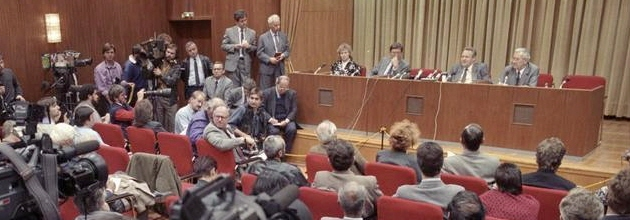Just one link today. It’s a video, and it’s a dandy, but unfortunately in German.
Never fear, your translator is here.
Please, at least watch the first nine minutes of this 40+ minute documentary that appeared on ZDF, Germany’s “second” public station. The name of the show is “Flucht in die Freiheit“, “Escape to Freedom”. (Note: it will ask you to select the speed of your connection so as to gauge the quality of the video it sends to you. I think it’s clear what the three Brandbreite (bandwidth) options are: they go from slowest to fastest. Select one and choose the link at the bottom-right labeled “Übernehmen”.)
“Escape to Freedom” tells the stories of many who escaped (or attempted to escape) East Berlin using techniques such as tunnel-digging, crossing with false passports, and … well, one guy found a pretty straightforward way to get out. And that’s the story of the first nine minutes of this show.
It concerns Wolfgang Engels, who is 19 years old and a civilian working with the National People’s Army in 1963. Here’s your guide to his story, the first nine minutes of “Escape to Freedom”…
00:00 — Introduction to the documentary, a hint of the kinds of escape attempts you will see in the show.
01:50 — Wolfgang Engels (19 years old) works for the National People’s Army (NVA). He arrives at a base in his nice car.
02:30 — Engels greets the soldiers who drive the armored vehicle. One of those drivers is interviewed for the documentary: “He drove a beautiful car — we were jealous of him.” They talk about the armored vehicles — “a discussion among men”.
03:00 — Engels interviewed today: “They were interested in my car, and I was interested in their armored vehicle. They were proud to show it to me. They even showed me the inside and let me climb in.”
03:15 — The soldier interviewed today: “He didn’t ask too intensively. He made it sound casual.”
03:30 — Engels asks them a lot of questions. How does it work? How does start it up? How does one get it in to gear?
03:55 — One of those soldiers interviewed today: “No, no, [we had] no suspicions.”
04:00 — 17 April 1963: His chance comes as the soldiers go to the mess hall. “I climbed in and drove away.”
04:30 — A sentry signals for him to stop. He breaks easily through the chain at the gate.
04:45 — One of those soldiers interviewed today: “Now it was clear to us that he wanted to flee the country. It couldn’t have been anything else.”
05:05 — Travel time to the Wall is 20 minutes. No one follows him. It was nothing unusual to have a military vehicle on the streets of East Berlin.
05:20 — The only traffic light on his route happened to be red as he approached it. But the policeman stationed there turned it to green for him, following normal procedure.
05:45 — He reaches the place where he wants to break through. There is no turning back now.
06:18 — There he goes, into the Wall!
06:34 — “Part of the hood of the vehicle was in West Berlin, but the doors were still in East Berlin.”
06:43 — East German border police open fire. Engels: “I felt the shot like a kick in my side. Then it just felt hot. But I was still able to get back into the vehicle, then climb up to the front and up on to the wall where the barbed wire was.”
07:15 — “I laid there and the border police continued to fire at me.”
07:25 — Covered by West Berlin policemen who fired back, civilians are able to pull Wolfgang Engels down from the wall into West Berlin. He is critically wounded. They take him to a tavern.
07:42 — “From the floor where I was laying — just in front of the bar — I could see the several brands of liquor that we East Berliners only knew about from advertisements. And then I knew: ‘You made it.'”
08:05 — The story hits the western newspapers. The escape of 19 year-old Wolfgang Engels is a sensation. He leaves the hospital weeks later.
Great story!

 P.S. “The Lives of Others”, the film whose trailer is shown above, is now available on DVD at Amazon.com, Amazon.co.uk, Amazon.ca and — in the original German — at Amazon.de.
P.S. “The Lives of Others”, the film whose trailer is shown above, is now available on DVD at Amazon.com, Amazon.co.uk, Amazon.ca and — in the original German — at Amazon.de.












